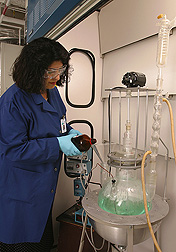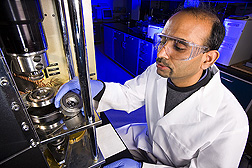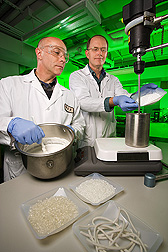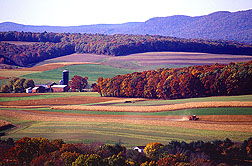From Lubricants to Packaging Materials
ARS Scientists Just Say“No”to Petroleum
Screech!
Few sounds are more nerve-wracking than the scraping of metal on metal. It’s the job of lubricants to prevent that annoying noise by making sure that—when metal touches metal—everything moves smoothly and quietly.
Machines that have moving parts—your car’s engine or the hydraulic pump of a huge earthmover, for instance—almost always require lubricants. Most lubricants are made of so-called “base oil” that’s blended with additives to boost performance.
In the United States, the demand for additives, already at nearly 2 billion pounds a year, is expected to increase at a respectable 2 percent a year for the next 5 years. That’s why Sevim Z. Erhan and colleagues have developed a new process for making biobased additives, ones suitable for use in formulating greases; crankcase, two-cycle, and marine engine oils; and hydraulic, transmission, and drilling fluids.
The additives would be made from the predominant fat molecules—triglycerides—in natural oils of familiar crops like soybean, corn, or canola or from lesser-knowns like pennycress, camelina, and crambe. Fully biodegradable, these vegetable-oil-based additives are just slightly darker, and somewhat thicker, than the clear, light-yellow cooking oils used in home kitchens across America.
|
|
The additives would provide an alternative to today’s petroleum-based products—and a potentially profitable market for growers in the Midwest and elsewhere.
Erhan did the work while a chemist at the ARS National Center for Agricultural Utilization Research in Peoria, Illinois. She’s now director of the agency’s Eastern Regional Research Center in Wyndmoor, Pennsylvania.
The new-age additives, says Erhan, offer many benefits and, to date, no downside. “You can use them with either biobased or conventional lubricants,” she points out. And the novel additives meet all the standard criteria for a top-notch, antifriction, antiwear additive, namely, impressive viscosity and liquidity, high flashpoint, and stability despite temperature extremes.
In small-scale laboratory tests to evaluate wear and friction, for example, the plant-oil additives performed as well as or better than commercial petroleum-based additives. And since they’re fully biodegradable, proper disposal is fast, easy, and inexpensive.
What’s more, the additives can be produced with the same equipment that chemical companies already have in place for making traditional additives.
It’s no wonder that several leading makers of petroleum-lubricant additives have already expressed an interest in the scientists’ process for making the biobased additives.
Erhan and coinvestigators Brajendra K. Sharma of Pennsylvania State University-University Park, and Atanu Adhvaryu, formerly with the university, describe the technology in their U.S. patent, issued in 2007. Importantly, the procedure and the resulting additives are eco-friendly. “No harsh solvents are used, and very little energy and water are required,” says Erhan.
In brief, the vegetable oil is allowed to react with several chemicals, for various periods of time, including a 4-hour stint at a boil. Savvy chemists would summarize the process as “reacting triglyceride oils with thiols to yield poly (hydroxy thioether) derivatives.”
Plant Starch—Not Polystyrene
Just as the environmentally sound additives might help lessen America’s dependence on petroleum, so too might starch-based foams replace polystyrene products. An example: the rigid, custom-fit foam pieces used inside cardboard cartons to keep computer monitors securely in place during shipping and storage. Those foam pieces could just as easily be made from wheat, potato, or corn starches instead of petroleum.
That’s according to Gregory M. Glenn, a plant physiologist with the ARS Western Regional Research Center in Albany, California.
Glenn and co-inventor Simon K. Hodson, formerly with EarthShell, LLC, of Lebanon, Missouri, have patented two “green” processes for making top-performing, starch-based foams for a multitude of everyday products—shipping liners, disposable dinnerware, and more.
These biofoams, which look like familiar polystyrene foam goods, are strong, durable, and versatile, Glenn says. They can be manufactured to the same range of densities as conventional foams and can be die-cut or molded into a seemingly limitless array of shapes, sizes, and thicknesses.
The starch-derived foams aren’t waterproof, however, so a moisture barrier needs to be added. But such barriers are nothing new and, in fact, can be derived from plant sources, such as corn, so that the finished biofoam product would still be made exclusively from renewable, biodegradable natural resources.
The Shape of Things To Come
Glenn has worked with both of the new processes in small-scale experiments at his laboratory. Both technologies rely on an extruder—a standard piece of equipment—to heat and mix a doughlike blend of starch and other all-natural compounds.
For one process, the extruder squeezes out long strings of the dough, referred to as a “thermoplastic melt,” that are later cut into small beads, about half the size of a marble. At various points in the process, the beads puff and expand. That happens, for instance, when the beads are put into the cavity of a heated mold, to press them into the desired shape.
Expanded beads will eventually touch one another, creating a strong matrix that’s much like the bead matrix of polystyrene foams.
The second process that Glenn and Hodson developed results in a mix that emerges from the extruder as a continuous hollow tube. As it moves, it is slit along one length so that instead of being rounded, it opens flat, just like a book that’s opened to lie flat on a table.
The now-flat foam is then rolled up—like a bolt of cloth—and stored. Later, it can be heated, unrolled, and die-cut into the desired product.
To enhance the strength of the foams, natural fibers—from a softwood such as southern pine—can be added to the mix before it goes into the extruder, reinforcing the foam for heavy-duty jobs.
The mounting environmental costs of landfills increasingly stuffed with nonbiodegradable polystyrene may eventually make Earth-friendly, biobased foams the preferred choice for tomorrow.—By Marcia Wood, Agricultural Research Service Information Staff.
This research is part of Quality and Utilization of Agricultural Products, an ARS national program (#306) described on the World Wide Web at http://www.ars.usda.gov/research/programs.htm.
To reach the scientists mentioned in this article, contact Marcia Wood, USDA-ARS Information Staff, 5601 Sunnyside Ave., Beltsville, MD 20705-5129; phone (301) 504-1662, fax (301) 504-1486.
Wrapping Up With Dairy-Derived Ingredients
Speaking of saying “no” to petroleum-based products, many food manufacturers want to incorporate renewable materials into their operations to help reduce food-packaging waste.
Most food packages are made of multilayer films that are thin, continuous sheets of synthetic polymers. But consumers and food retailers are concerned about the waste generated during the manufacture of such packaging. Many, it seems, are interested in replacing petroleum-based packaging with biobased packaging.
At the ARS Eastern Regional Research Center in Wyndmoor, Pennsylvania, scientists are developing strong, biodegradable dairy-based films that are better oxygen barriers than petrochemical-based films. “We are involved with finding the technology to improve dairy films so that they can eventually perform as plastics,” says research leader Peggy Tomasula, with the center’s Dairy Processing and Products Research Unit.
She wrote “Using Dairy Ingredients To Produce Edible Films and Biodegradable Packaging Materials,” a book chapter in the soon-to-be-published Dairy-Derived Ingredients: Food and Nutraceutical Uses, by London-based Woodhead Publishing.
The chapter focuses on films made from dairy proteins, with an emphasis on those based on casein and whey, the major proteins found in milk. It also covers research efforts to improve the proteins’ mechanical and barrier properties so that these natural materials could eventually be used in a variety of applications.
As a dairy ingredient, casein shows good adhesion to different substrates. But while casein is an excellent barrier to oxygen, carbon dioxide, and aromas, it is a weak barrier to moisture. “The water-soluble nature of these proteins is a big problem,” says Tomasula. “Much of the research on edible casein films to date is directed to improving their water-vapor barrier properties. The use of dairy-based films as part of multilayered packaging systems will be the focus of future research.”—By Rosalie Marion Bliss, Agricultural Research Service Information Staff.
|
|
For Sustainability Smarts: The National Agricultural Library’s “Sustainable Agriculture Information Tools” Website
You’re interested in learning more about sustainable farming, but you don’t want to spend a lot of time surfing the web.
No worries.
Expert librarians at the National Agricultural Library in Beltsville, Maryland, and Washington, D.C., have done the homework for you, compiling handy resources at http://afsic.nal.usda.gov/.
Scroll down to the “Learn More” headings to find an interesting potpourri of clickables, all leading you to reliable, authoritative resources. All are carefully vetted by the pros at the library’s Alternative Farming Systems Information Center.
Get backgrounded quickly—and become fluent in the lingo—by skimming “Sustainable Agriculture: Definitions and Terms.”
Check out the comprehensive “Sustainable Agriculture Automated Database Searches.” Anywhere from thousands to millions of documents were sifted and winnowed to find those most relevant and of the highest quality.
Curious about scientific journals? You’ll want to view the library’s top picks, posted at “Sustainable Agriculture: Top 10 Research Journals.”
Have college-age kids or grandkids who might be interested in studying sustainable ag? They’ll definitely want to read “Educational and Training Opportunities in Sustainable Agriculture,” which covers everything from the nation’s longest-running undergraduate degree program in organic farming (Washington State University-Pullman) to the University of New Hampshire’s new “eco-gastronomy” program, an eclectic blend of nutrition, food, and farming.
Updated frequently, the library’s sustainable agriculture website is widely regarded as among the best of its kind.—By Marcia Wood, Agricultural Research Service Information Staff.
"From Lubricants to Packaging Materials: ARS Scientists Just Say “No” to Petroleum" was published in the September 2009 issue of Agricultural Research magazine.











